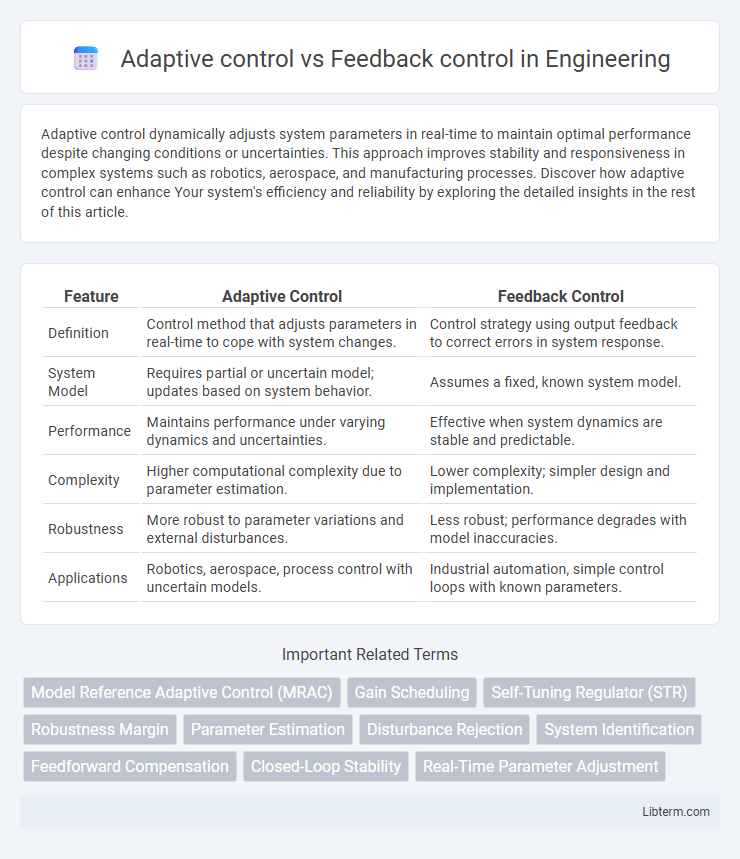Adaptive control dynamically adjusts system parameters in real-time to maintain optimal performance despite changing conditions or uncertainties. This approach improves stability and responsiveness in complex systems such as robotics, aerospace, and manufacturing processes. Discover how adaptive control can enhance Your system's efficiency and reliability by exploring the detailed insights in the rest of this article.
Table of Comparison
| Feature | Adaptive Control | Feedback Control |
|---|---|---|
| Definition | Control method that adjusts parameters in real-time to cope with system changes. | Control strategy using output feedback to correct errors in system response. |
| System Model | Requires partial or uncertain model; updates based on system behavior. | Assumes a fixed, known system model. |
| Performance | Maintains performance under varying dynamics and uncertainties. | Effective when system dynamics are stable and predictable. |
| Complexity | Higher computational complexity due to parameter estimation. | Lower complexity; simpler design and implementation. |
| Robustness | More robust to parameter variations and external disturbances. | Less robust; performance degrades with model inaccuracies. |
| Applications | Robotics, aerospace, process control with uncertain models. | Industrial automation, simple control loops with known parameters. |
Introduction to Control Systems
Adaptive control dynamically adjusts controller parameters in response to changes in system dynamics or external disturbances, enhancing performance in uncertain or varying environments. Feedback control relies on real-time measurement of system output to correct deviations from desired behavior using predefined control laws. Both methods are fundamental in control systems, with adaptive control providing flexibility while feedback control ensures stability and accuracy.
Fundamentals of Feedback Control
Feedback control fundamentally relies on continuously measuring system output and comparing it to a desired reference to reduce error through corrective actions. It typically assumes fixed system parameters and uses Proportional-Integral-Derivative (PID) controllers to maintain stability and performance in the presence of disturbances. Adaptive control extends feedback control by dynamically adjusting controller parameters in real-time to accommodate system uncertainties and changing conditions for improved robustness.
Principles of Adaptive Control
Adaptive control continuously adjusts controller parameters in real-time based on system performance to handle uncertainties and dynamic changes, unlike fixed-parameter feedback control which relies on a predetermined controller design. It employs parameter estimation algorithms and real-time system identification to modify control laws, ensuring stability and robustness in varying conditions. This approach is crucial in applications with nonlinearities, time-varying dynamics, or unknown disturbances where conventional feedback control may fail to maintain optimal performance.
Key Differences Between Adaptive and Feedback Control
Adaptive control dynamically adjusts its parameters in real-time to handle system uncertainties and changing environments, whereas feedback control relies on fixed parameters to correct errors based on the difference between desired and actual outputs. Feedback control systems use past and current output measurements to maintain stability and performance, while adaptive control continuously estimates system behavior and updates control laws accordingly. Key differences include the adaptive control's capability to manage non-linearities and time-varying system dynamics, contrasted with the feedback control's simpler implementation suited for stable, well-modeled systems.
Advantages of Feedback Control Systems
Feedback control systems provide robust performance by continuously monitoring output and adjusting inputs to maintain desired system behavior despite external disturbances or internal variations. They offer increased stability and accuracy in dynamic environments through real-time error correction, reducing steady-state errors and improving system responsiveness. This type of control is particularly effective in linear systems where system parameters remain relatively constant, ensuring consistent operation without requiring extensive model updates.
Benefits of Adaptive Control Systems
Adaptive control systems offer significant benefits over traditional feedback control by continuously adjusting controller parameters in real-time to handle system uncertainties and changing environments. This capability ensures improved system performance, enhanced robustness, and greater stability in nonlinear or time-varying processes. Adaptive control is particularly advantageous in aerospace, robotics, and automotive applications where precise, dynamic adjustments are critical for maintaining optimal operation.
Limitations and Challenges of Feedback Control
Feedback control systems face limitations in handling dynamic environments where system parameters change rapidly or unpredictably, leading to degraded performance or instability. They struggle with delays and nonlinearities, which can cause oscillations or slow response times, making them less effective in complex or time-varying processes. Unlike adaptive control, feedback control lacks the ability to self-tune and adjust to disturbances or model uncertainties, restricting its robustness and flexibility.
Adaptive Control: Use Cases and Applications
Adaptive control excels in systems where dynamic changes and uncertainties are prevalent, such as aerospace engineering for flight control under varying aerodynamic conditions and robotics for real-time adjustments in unpredictable environments. Its ability to modify controller parameters online makes it ideal for process industries including chemical reactors where reaction dynamics shift continuously. Adaptive control also finds use in automotive systems, optimizing engine performance and emissions despite changing load and environmental factors.
When to Choose Adaptive Over Feedback Control
Adaptive control is preferred over feedback control when system dynamics are unknown, time-varying, or subject to significant uncertainties that standard feedback mechanisms cannot compensate for. In scenarios involving nonlinearities, parameter variations, or external disturbances, adaptive control continuously adjusts controller parameters to maintain desired performance. Feedback control suffices when system models are accurate and disturbances are minimal, but adaptive control excels in environments demanding real-time adaptation to changing conditions.
Future Trends in Adaptive and Feedback Control
Emerging trends in adaptive control emphasize the integration of artificial intelligence and machine learning algorithms to enhance system responsiveness and robustness in uncertain environments. Feedback control is evolving through the development of advanced sensor technologies and real-time data analytics, enabling precise adjustments in highly dynamic systems. The convergence of adaptive and feedback control strategies is driving innovations in autonomous systems, robotics, and smart manufacturing processes, optimizing performance and resilience.
Adaptive control Infographic

 libterm.com
libterm.com